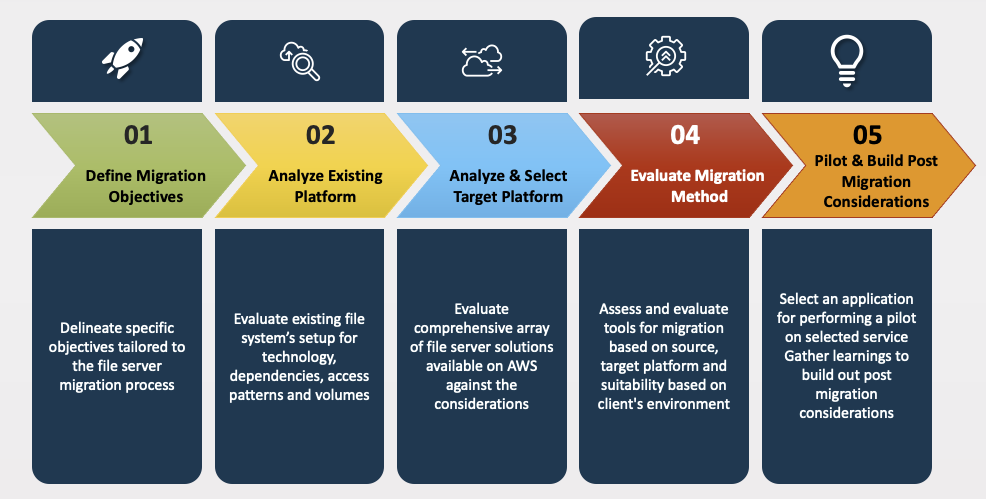Migrating File Servers to AWS : Guide to kick start your assessment

Anand Apte
Principal Solutions Architect

Anand Apte
Principal Solutions Architect
Introduction
Digital transformation is at the centre of IT and Business strategies for many organizations and is considered as the cornerstone of organizational success. Data (structured or unstructured) is always at the core and as such modernizing data storage to the cloud stands as a pivotal step toward efficiency, scalability, and modernization. As businesses increasingly recognize the advantages of cloud-based file storage solutions, the path to a successful migration begins with a thorough assessment of the existing file server environment.
Through this quick assessment guide we will attempt to unravel the complexities of file server migrations to AWS. We will try to equip you with the insights and strategies necessary to navigate this assessment phase so that your migration journey is smooth and is aligned to your IT and Business goals.
Assessment Process
Any migration assessment, file servers in particular could be performed through five steps.

01 – Define Migration Objectives
While the comprehensive Migration Readiness Assessment (MRA) based on Cloud Adoption Framework (CAF) should to performed to understand broader migration and cloud adoption objectives, it’s essential to delineate specific objectives tailored to the file server migration process. These objectives will directly address the unique considerations tied to migrating file servers and the specific benefits they will unlock.
Defining tangible objectives can be hard. You can try to formulate them through a series of questions like below –
- How important is it for your file server environment to seamlessly scale storage resources while maintaining optimal file access performance for users?
- If answer to this question is rated “Important”, “Very Important” or “Crucial” it signals “Scalability and Performance Enhancement” as your key objectives.
- Are you looking to reduce on-premises infrastructure costs and shift from capital expenses to an operational expenditure model?
- If answer to this question is Yes, “Cost Optimization” becomes one of your key objectives.
- Do you have specific data security and compliance requirements that need to be upheld during the migration process and beyond?
- If answer to this question is Yes, “Data Security & Compliance” becomes another one of your key objectives.
- Are you aiming to provide improved file accessibility to geographically dispersed users?
- If answer to this question is Yes, “Geographic Reach and Accessibility” becomes another one of your key objectives.
- Similarly you could formulate questions and understand if some of the generic objective like “Improved Disaster Recovery & Business Continuity”, “Improved End User Experience“ and “Reduce Vendor Lock-In” apply to your scenario as well.
02 – Analyze existing platform
Upon establishing your migration objectives, a comprehensive evaluation of your existing file system’s setup, encompassing its dependencies, access patterns, file volumes, and more, becomes imperative. This assessment serves as the cornerstone for gauging the file system’s readiness for migration and determining the optimal target solution.
| Assessment Category | Assessment Key Areas | Assessment Details |
| Execution Architecture | Data Store Architecture | Understand the existing data store setup, including types of data store (local or shared), directory structure (if it’s a file system) and organization of data. Identify complex configurations (such as symbolic links) that may impact migrations. Understand the data volumes and size, including the rate of data growth etc. |
| Application / User Integration & Access Patterns | Identify the applications, processes, systems or end users who interact with the data store and how is it currently done. Identify access patterns such as sequential access, random access or small file operations to choose the most suitable storage service on cloud. | |
| Network Connectivity | Assess the network connectivity between current applications and file system and from on-premises environment to AWS. Gather details on whether there is any adjustment needed on the network bandwidth over direct connect / VPN to ensure efficient data transfer and low latency. | |
| Performance | Understand the performance requirements of the data store including read/write operations, IOPS and throughput. Gather the available performance metrics and benchmarks. Understand if the current solution needs additional caching mechanism to achieve similar performance as available currently. | |
| Security & Access Control | Understand the current access control mechanisms and permissions on the data store. Evaluate how this will be implemented on AWS using IAM and security groups. | |
| Operations Architecture | Backup & Disaster Recovery | Understand the current implementation of backup and disaster recovery procedures and whether migrated data store can be integrated to the existing recovery procedures. Understand if cloud backup and disaster recovery processes will be sufficient from operational readiness and ongoing operations point of view. |
| Health & Performance Monitoring | Understand what tools are currently used for health and performance monitoring of the data store. Understand whether same tools will continue to assess the health and performance of migrated application or some other tools will have to be integrated / built. | |
| Development Architecture | Development & deployment tools | Understand what tools are currently used for development and deployment of the application. Understand whether same tools will continue to be used for the migrated application or some other tools will have to be integrated / built. |
It is always good to substantiate your decision-making for the target solution by anchoring it in the thorough assessment. Placing the file system under the scrutiny of a decision tree lends a structured approach to this process.
03 – Analyze and select target platform
AWS stands as a versatile platform offering a comprehensive array of solutions for hosting the target file server systems. Within this ecosystem, we can find an array of options tailored to accommodate specific requirements for file system migration. These include –
AWS stands as a versatile platform offering a comprehensive array of solutions for hosting the target file server systems. Within this ecosystem, we can find an array of options tailored to accommodate specific requirements for file system migration. These include –
Amazon FSx for Windows File Server
- A fully managed Windows-native file system with native support for SMB.
- Ideal for migrating Windows-based file servers, providing compatibility and ease of transition.
Amazon FSx for Lustre
- High-performance file system optimized for compute-intensive workloads.
- Suited for scenarios requiring rapid data access and processing.
Amazon FSx for NetApp ONTAP
- A fully managed file storage service that supports NFS, SMB, and other protocols.
- Offers advanced data management features and integration with NetApp ONTAP capabilities.
Amazon FSx for OpenZFS
- A fully managed file storage service that supports POSIX-compatible file systems using the OpenZFS technology.
- Offers data integrity, snapshot capabilities, and compatibility with Linux applications.
Amazon EFS (Elastic File System)
- Scalable, fully managed file storage that supports NFS protocol.
- Appropriate for applications needing shared access to files across multiple instances.
Amazon S3 (Simple Storage Service)
- Object storage service that can serve as a target solution for specific file-based use cases.
- Can be integrated with applications using the S3 API or accessed indirectly using third-party tools.
Amazon EC2 (Elastic Compute Cloud) with Self-Managed File Systems
- Running traditional file servers on EC2 instances and managing the file system setup.
- Offers flexibility but involves more management compared to managed AWS file systems. This solution can be used where you are targeting to rehost the file system AS-IS.
04 – Evaluate Migration Method
Within the AWS ecosystem, diverse array of services and tools are available to facilitate the migration of the file system to the cloud. Moreover, native tools such as Robocopy and Rsync can be used if you intend to capitalize on your existing team’s expertise and tailor your migration approach to precise requirements.
| Services / Tools | Description | When to use? |
|---|---|---|
| AWS DataSync | AWS DataSync is a secure, online service that automates and accelerates moving data between on premises and AWS Storage services. | When you need to transfer a large amount of data to AWS at high speed along with regular data sync between twp platforms. |
| AWS Snowball | Physical data transport solutions that help you transfer large amounts of data into and out of AWS using secure appliances. | When you are dealing with petabyte-scale data and are limited by limited network bandwidth or remote or challenging environments. |
| AWS Snowcone | Small, portable, rugged device for edge computing and data transfer. | When you are dealing with extremely remote or challenging environments where standard computing infrasturcture isn’t available. |
| AWS Transfer Family | Fully managed file transfer service, which enables you to transfer files into and out of Amazon S3 using protocols like FTP, FTPS, and SFTP. | When you are looking for a quick setup, ease of user and management, seamless integration to AWS services like S3. |
| Robocopy (Windows) | A command-line tool used for robust file copy operations on Windows systems. | When you are dealing with complex file structure with specific rules & permissions, selective copying based on file attributes, timestamps etc, dealing with Windows specific environment and want to preserve NTFS permissions. |
| Rsync (Linux/Unix) | A widely used utility for syncing and transferring files between machines, often used for migrating file systems. | When you are dealing with Linux / Unix environments, are looking to achieve network efficiency (Rsync’s delta transfer algorithm helps with this), are looking to have incremental backups during the migration process and want to preserve permissions and attributes. |
| SnapMirror | NetApp data replication technology that allows you to replicate data from on-premises NetApp storage systems to NetApp-based storage systems in AWS, such as AWS FSx for NetApp ONTAP | If you are already using NetApp storage systems on-premises, SnapMirror provides seamless integration with your existing infrastructure. If your organization relies on advanced features offered by NetApp, such as data deduplication, compression, thin provisioning, and snapshots, SnapMirror can replicate and maintain these features in the destination system, ensuring data consistency. |
05 – Pilot & Build Post Post Migration Considerations
It is crucial to perform a pilot based on above to confirm the approach readiness and refinement. As you go through doing a pilot It is crucial to closely monitor the system to ensure additional steps to be taken to ensure data integrity and optimal performance. At the same time, its important to look at best practices for ongoing management, monitoring, and optimization of file storage in AWS.
Testing & Validation
- Continue to verify the integrity of transferred data by comparing checksums or performing sample checks to ensure data consistency in the pilot phase.
- Continue to review and configure file and folder permissions to ensure that users and applications have the appropriate access rights.
- Gather metrics around performance and validate that there are no latency issues introduced.
Setup for Future
- Setup processes for conducting regular security audits to validate that the migrated file system complies with the organizational security policies and industry standards.
- Setup data lifecycle management strategies to efficiently handle data retention, archival, and deletion.
- Setup Well Architected Review to establish a production baseline, identify improvement plan and implement.
Conclusion
Migrating file systems to AWS presents a transformative opportunity for organizations to enhance scalability, security, and performance while leveraging a wide array of tools and services. Thorough assessment, strategic planning, and meticulous execution form the cornerstone of a successful migration journey. By aligning objectives, considering specific use cases, and adhering to best practices, businesses can seamlessly transition their file systems to the cloud, reaping the benefits of increased agility and innovation. The post-migration phase, marked by vigilant monitoring, fine-tuning, and user support, solidifies the migration’s success and sets the stage for continued optimization in the AWS environment. We at Versent can always help you do assessments for your file system migrations and set you up for success.
Great Tech-Spectations

Great Tech-Spectations
The Versent & AWS Great Tech-Spectations report explores how Aussies feel about tech in their everyday lives and how it measures up to expectations. Download the report now for a blueprint on how to meet consumer’s growing demands.